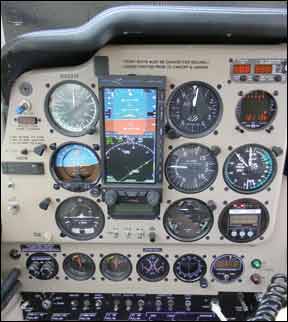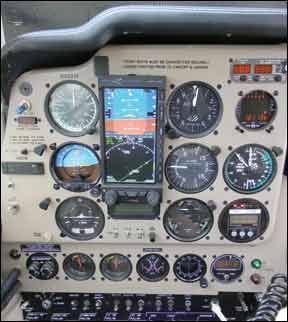These days, vacuum- or air-pressure-driven instruments in an otherwise glass panel seem like the proverbial fish out of water: All that spiffy new technology parked next to stone-age holdovers. Vacuum/air pumps and the unreliable spinning gyros they feed are pre-WWII technology, heavy and involve problematic plumbing systems. The irony has many owners thinking of removing their air/vacuum system entirely. Though it’s not without its drawbacks—which we’ll get to—going all-electric has several benefits, including weight savings, simplified maintenance and troubleshooting, and elimination of the failure-prone dry pumps and plumbing once and for all.

288
If you are venturing on a glass-panel upgrade that includes the Aspen PFD or Garmin G500, for example, you’ll still need a round-gauge horizon gyro to back it up. But this instrument doesn’t necessarily have to be vacuum-driven: You could make the switch to an electric backup while ditching the vacuum system, but there are some important guidelines to follow when making this bold upgrade. Of course, if the airplane has pneumatic de-ice boots, you’re stuck with the pump. Herewith are some tips on properly making the vacuum to electric transformation and living with it once you fly it home.
Pneumatics 101
In case you started your flying career in an all-glass airplane or don’t remember the basics of air-driven gyroscope theory—or the relatively unreliable track record that tags along—here’s a brief review.
Spinning gyros of the non-electric variety (directional and attitude instruments, mainly) rely on a pneumatic source delivered through a pressure or vacuum-creating engine-driven air pump. The pump is mounted to an engine accessory pad and connected to the panel-mounted instruments by a space-eating web of hoses, tubing and accessories. Air pressure generated by the pump is passed through a regulator, filter, lines and fittings before it’s piped into the instruments, where the stream of air causes the gyros to erect and spin at high RPM. A vacuum system does the same basic thing, but in reverse, by sucking air first through a filter, then through the instruments, to the pump and overboard.
There are two basic types of engine-driven pumps: wet and dry. Wet pumps use engine oil to lubricate their internals while dry ones depend on self-lubricating graphite vanes. (The sidebar on page 15 has more on the differences between wet and dry pumps.) A pressure system also is commonly used to inflate de-icing boots. The rub is that pneumatic de-icing boots makes your airplane a non-player for ditching the pneumatic system. You still can go with an all-electric panel, you just won’t see much of a weight savings, if any.
Finally, in some airplanes, the system is used power pneumatically-driven autopilots—kudos to you if you have one of these autopilots still functioning. But unless you want to go to the additional time and significant expense to install a modern autopilot, you’ll still want to retain the pump and associated plumbing, again negating some of the benefits of going all-electric.
Pull it all out?
The prospect of yanking the pneumatic system from the airplane comes full circle during the install of an electric PFD (primary flight display) because both heading and attitude information will be displayed there and it’s where your eyes will be focused unless the system fails. Arguably, the digital data source of a certified PFD system is far more reliable than a vacuum pump and gyro combination.
Then there’s the weight savings. Consider a vacuum system to include an airborne pump, heavy-duty rubber vacuum hoses, various fittings and filters plus gyros. That’s what was removed from the N35 Bonanza pictured on the opposite page. The change easily nixed 10-plus pounds off the airplane’s weight. Better still was the reduced clutter behind the instrument panel and the 2-inch instrument hole the vacuum gauge vacated in a packed panel.
Removing a vacuum system might be a tag-team effort by an avionics and maintenance facility: Maybe the maintenance folks remove the accessories from the engine bay while the avionics people remove the vacuum gauge, lines and accomplish the gyro work in the panel. The maintenance guys likely will be involved installing any backup alternator or battery, also.
Big-Buck Gyros Meet The Fars
The next step in the all-electric upgrade includes selecting an electric attitude gyro. Hold onto your wallet because here’s where it can get pricey, causing some owners to fall back in love with their vacuum systems. And since you’ll likely be backing up a retrofit glass PFD, you’re bound by the requirements in the PFD’s STC and installation manual. The STC/install manual for both the Aspen and Garmin retrofit systems offer at least some guidance for what type of gyros are fair game for use as a backup.
For instance, Aspen’s install manual says their EFD1000 PFD installation needs to include a second attitude indicator with a separate power source to operate the unit for at least 30 minutes. Obviously, a vacuum-driven horizon qualifies. But a plane-Jane electric gyro without a battery backup doesn’t. And, the backup gyro has to reside in the pilot’s panel within stated visual scan parameters. These requirements exist despite the backup battery living inside every Aspen display. A second Aspen screen won’t lift the requirement for a backup horizon—yet.
Further, the FAA has a regulation that specifically addresses backup power in glass panels. It’s FAR 23.1353(h) and says any storage battery must supply 30 minutes of power—a guideline manufacturers follow during certification. Aspen doesn’t necessarily recommend any particular model of gyro but Garmin’s G500/600 PFD STC does.
From my experience, Garmin has good reason for including the Mid-Continent 4300-series Lifesaver gyro in its guidance. It’s rated for 7500 hours mean time between failure, has integral battery backup to keep the gyro spinning for an hour, has anti-reflective glass for less fatigue and is available in multiple panel tilt with internal lighting. I’ve also witnessed good service and reliability from the Castleberry 300-series gyro when saddled to EPU emergency battery.
Changing the Way You Fly
Most pilots that have made the transition to an all-electric retrofit panel admit to an initial paranoid reluctance. Despite the relative unreliable nature of vacuum systems and the gyros they power, initially it may be tough to relax knowing that you’re relying on a single source for controlled flight, despite the backup you’ve created with emergency batteries and upgraded charging system, perhaps along with a portable GPS and even an iPad.
Whatever checklist you follow when flying behind a vacuum system might change at least a bit when going all-electric. For sure, you’ll be looking harder and more often at bus voltage and amp gauge, if equipped. You also may have a pre-flight check to perform, verifying the backup gyros’ power is working.
Meanwhile, most modern engine monitors have voltage monitoring and warning capabilities you should incorporate into your scan and checklist.
Davtron and others offer dedicated voltage monitors that measure bus voltage. They can serve as initial warning that something’s gone wrong with a charging system. Backup instrument batteries like the one in the Mid-Continent gyro flag the pilot when they lose input voltage, but it’s up to the pilot to manually activate the battery and pull the cage knob on the gyro for quick erection.
And for goodness’ sake, maintain a healthy battery. I’m amazed at the number of owners tooling around in bitterly cold climates with batteries nearly five-plus years old. Not only will the battery eventually leave you stranded (or paying the FBO for a cart-start) but it puts additional stress on an already-taxed system. Many experts recommend replacing batteries after three years of service.
Conclusion
From a dollars and cents view, making an all-electric investment now can save you money in the long haul. This is especially true if your airplane is prone to dry vacuum/pressure pump failures and given the average cost of replacing a high-quality vacuum horizon. Change out a couple of these gyros and/or pumps over the span of a few years and the prospect of going all-electric is much more appealing. For some, having the redundancy of pneumatics to back up their electrical system is appealing, too.
Going vacuum-less is a huge blow to the budget because installing a standby alternator, upgrading the primary alternator and nursing an older or puny 14-volt system can up the investment considerably. This is above and beyond the cost of the PFD and autopilot gyro emulator, if needed. Finally, save some money for a good portable GPS along with a handheld communications radio, both of which should be an integral part of your all-electric plan. If all that expensive electric gear leaves you staring at dark screens, portables running on batteries could be your only hope.
Larry Anglisano is the avionics editor of sister publication Aviation Consumer and works with an avionics shop in Connecticut.




